

Cascading Style Sheets. CSS is designed primarily to enable the separation of document content from document presentation, including elements such as the layout, colors, and fonts.[1] This separation can improve content accessibility, provide more flexibility and control in the specification of presentation characteristics, enable multiple pages to share formatting, and reduce complexity and repetition in the structural content (such as by allowing for tableless web design).
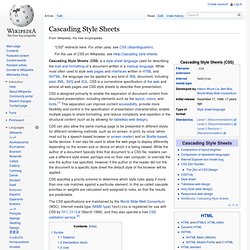
CSS can also allow the same markup page to be presented in different styles for different rendering methods, such as on-screen, in print, by voice (when read out by a speech-based browser or screen reader) and on Braille-based, tactile devices. It can also be used to allow the web page to display differently depending on the screen size or device on which it is being viewed. CSS specifies a priority scheme to determine which style rules apply if more than one rule matches against a particular element.
HTML element. In the HTML syntax, most elements are written with a start tag and an end tag, with the content in between.
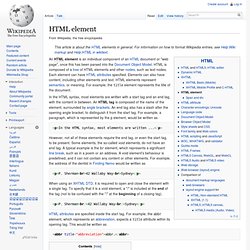
An HTML tag is composed of the name of the element, surrounded by angle brackets. An end tag also has a slash after the opening angle bracket, to distinguish it from the start tag. HTML element. In the HTML syntax, most elements are written with a start tag and an end tag, with the content in between.
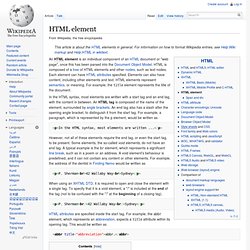
An HTML tag is composed of the name of the element, surrounded by angle brackets. An end tag also has a slash after the opening angle bracket, to distinguish it from the start tag. Manual of Style (infoboxes) An infobox template is a panel, usually in the top right of an article, next to the lead section, (in the desktop view) or at the very top of an article (in mobile view), that summarizes key features of the page's subject.
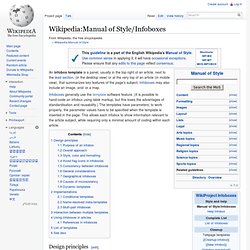
Infoboxes may also include an image, and/ or a map. Infoboxes generally use the template software feature. (It is possible to hand-code an infobox using table markup, but this loses the advantages of standardisation and reusability.) The templates have parameters; to work properly, the parameter values have to be specified when the template is inserted in the page. This allows each infobox to show information relevant to the article subject, while requiring only a minimal amount of coding within each article. Help:HTML in wikitext. The MediaWiki software allows use of a subset of HTML5 markup elements or tags and their attributes for presentation formatting.[1] Many HTML tags may also be included by equivalent wiki markup or templates which are simpler for most editors and less intrusive in the editing window.
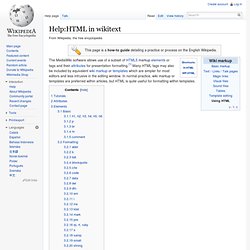
In normal practice, wiki markup or templates are preferred within articles, but HTML is quite useful for formatting within templates. Help:Cascading style sheets. Cascading Style Sheets allow for flexible formatting of a page.

They should be used instead of tables for non-tabular content whenever possible, because they can be manipulated by the reader or overridden by an author if your CSS is embedded in another page via a template. Levels of CSS settings[edit] Style may be specified specifically for a piece of content, see e.g. color; scope of parameters. Advanced editing. For the basics see Help:Editing.
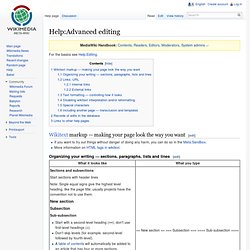
Wikitext markup — making your page look the way you want[edit] If you want to try out things without danger of doing any harm, you can do so in the Meta:Sandbox.More information on HTML tags in wikitext. Organizing your writing — sections, paragraphs, lists and lines[edit] Links, URL[edit] More information at Help:Link. Internal links[edit] General notes: Enclose the target name in double square brackets — "[[" and "]]".First letter of target name is automatically capitalized.Spaces are represented as underscores (but don't do underscores yourself).Links to nonexistent pages are shown in red — Help:Starting a new page tells about creating the page.When the mouse cursor "hovers" over the link, you see a "hover box" containing... hover over links hereafter to see.
External links[edit] By default, external links do not open in a new browser window. Text formatting — controlling how it looks[edit] Disabling wikitext interpretation and/or reformatting[edit] Help contents. Wiki color formatting help. Set text color by using <span style="color:#FF0000"> This text will be red </span> Set background color by using <span style="background:#00C000"> This text will be on a green background </span> Set both by using <span style="color:#FFFF00; background:#00C000"> This text will be yellow and on a green background </span>
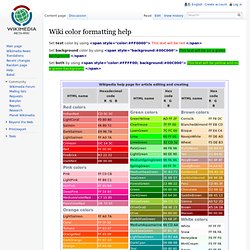
Cheatsheet. From Wikipedia, the free encyclopedia.

Manual of Style. The Manual of Style (often abbreviated MoS or MOS) is a style guide for all Wikipedia articles.

This is its main page, covering certain topics (such as punctuation) in full, and presenting the key points of others. Subpages, linked via this page's menu and listed at Wikipedia:Manual of Style/Contents, provide detailed guidance on some topics. The Manual of Style documents Wikipedia's house style. It helps editors write articles with consistent, clear, and precise language, layout, and formatting. The goal is to make using Wikipedia easier and more intuitive. Style and formatting should be consistent within an article, though not necessarily throughout Wikipedia. Table. This page gives you information about syntax to build wiki-tables in MediaWiki. Spreadsheet to wiki table format[edit] To convert from spreadsheets such as Gnumeric, MS Excel or OpenOffice.org Calc, see (Obsolete?) Using the toolbar[edit] You can use the Mediawiki edit toolbar to create tables on Wikipedia, and some Wikimedia projects. It is helpful to generate the necessary codings.
Use the first button on the right of the toolbar to insert a table when editing a page. By default, it includes the following text: Pipe syntax tutorial[edit] Although HTML table syntax also works, special MediaWiki code can be used as a shortcut to create a table. The entire table is encased with curly brackets and a vertical bar character (a pipe). {| table code goes here|}